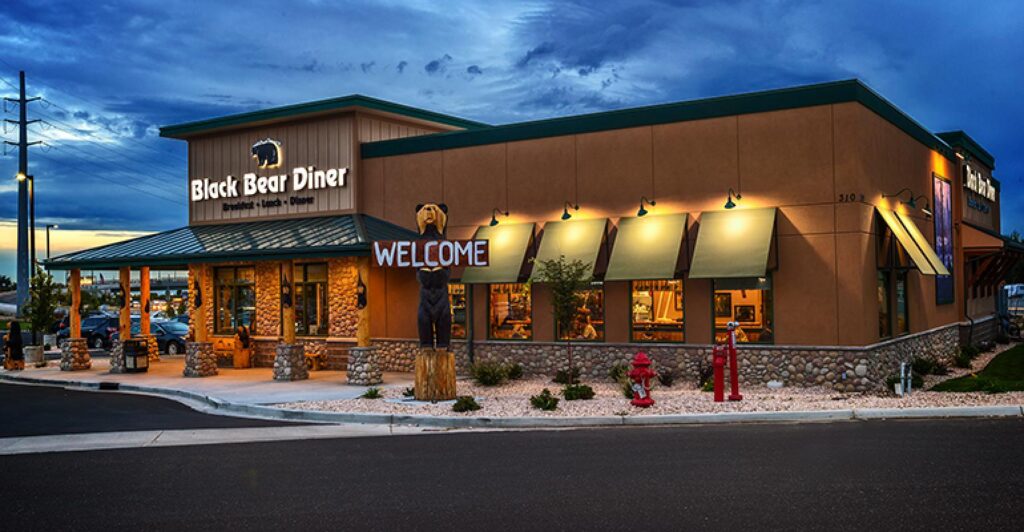In a long-planned leadership change-up, Anita Adams has been named CEO of casual dining concept Black Bear Diner.
Adams joined the company as CFO back in 2017, and in March 2019 she added the title of president to her role leading the finance department. Prior to that, Adams spent 24 years with various public and private companies, overseeing financial growth including a surge from $400 million to $1.2 billion at American Blue Ribbon Holdings, a franchise company with nearly 700 restaurants. She’s also no slouch when it comes to major transactions. For now, however, it’s business as usual.
“Really, it’s more of the same, really this last three to four years it’s been about development and growth and taking this brand to new markets. We’ve been incredibly pleased with the eastward expansion, so it’s continuing down that path,” said Adams when I caught up with her at the 2020 ICR conference, in her first week as CEO.
Don’t expect any big changes to that strategy. Black Bear Diner has been moving east concentrically from its 1995 birthplace of Mt. Shasta, California. The concept now has 138 locations with recent expansion into Kansas, Missouri and Texas, bringing the footprint to 14 states. In all, the concept opened about 20 locations in 2019 with a similar growth rate expected for 2020, favoring Texas and California.
As it expands, Adams said the team has been surprised by the welcome wagon in those new markets, most of which are in the 40 percent of company-owned locations for now.
“Our approach in new markets we think we should be the trailblazer and go out with the brand. But today, Texas, Oklahoma and Kansas, those are all corporate markets, but it’s not to say we wouldn’t invite franchisees to operate with us,” said Adams.
She said those new customers love the $14 price point, the scratch cooking and the many, many bears that are still hand-carved and make up the log cabin decor. But as they grow, the company is tweaking a few things. Training and labor are getting some updates as managing labor gets more difficult.
“We’ve always been focused on being a great employer, we’re really doubling down on labor,” said Adams, noting a special emphasis on those new locations.
“I think we have a really solid new-diner opening training, but we’re frankly looking at extending that training. We do a lot of scratch cooking, and when we think about the back of house, we have to have our chefs ready to open the doors,” said Adams.
The push forward on training brings a new VP of training into the mix and a new learning management system to turn the company into more of a “continual learning environment.”
Bruce Dean, former CEO and founder, said that has a direct impact on labor and retention. Simply put, “the more you train people, the more likely they are to stay,” said Dean.
The purposely low-tech concept is also bringing more technology into the locations. But don’t expect to see a tablet on the counter.
“The tech we’re introducing will be in back of house, it’s kitchen display systems, site selection tools and analytics. What we won’t do, we are about that experience, we want our guests to interact with the other people around the table,” said Adams. “Where it helps us in efficiency, all those tools that help manage the business better without losing that connection with the guest.”
The leadership change brings some other shuffling as well. Steve Sparks will expand his role as CFO, taking over the remanences of Adams’ finance duties. Jeff Guido will join as COO. Recently Guido served as president of the family restaurant division at American Blue Ribbon Holdings, overseeing Baker Square and Village Inn finances and above-store administration. The company made other additions to the leadership team in 2019: Joe Adney joined as chief marketing officer and Tammy Johns joined as chief people officer.
Dean will remain active with the company as executive chairman. But as a restaurant guy through and through, he won’t exactly be heading to the golf course. The creator of many of the best-selling recipes and the man who originally brought the “bear-sized” portions to the plate is still in the mix. But he will get to do some more fishing.
“I’m turning 65 next month, so it was time to turn the day-to-day over. But I’ll continue to be involved to provide brand leadership and staying close to our franchisees who trusted me and Bob [Manley] with their life savings to come aboard with us,” said Dean. “I’ll stay close to them, go to new diner openings, telling our story to staff and visiting diners.”
That big change from founder-led to outside leadership has been brewing for a few years. While Dean said it might not always be easy for him to watch from the sidelines, Adams is ready and poised for some great things.
“It was clear that she wasn’t just a number cruncher, she had an operational bent and provided me with some great insight, we’re just switching roles,” said Dean. “There’s a time of adjustment, but one thing I don’t want to do is get in her way.”
Adams said that while Dean gets some fishing done and gets more face time with franchisees, his story is still at the core of the company.
“Really, as we think about our legacy, we’re weaving that into our legacy and we talk about all this. People really understand the heritage and I think it means something to people, so we’re being purposeful about perpetuating Bruce’s view. We talk a lot about what our founders believe and it written into our values,” said Adams.
According to the company FDD, the diners had an average unit volume of $2.6 million and company sales were $335 million through 2019. The locations are typically 5,000- to 6,500 square feet, but the brand uses a “hermit-crab” strategy of finding second-generation spaces left vacant by other casual diners.
